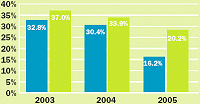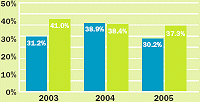Curriculum-Based Reform :: Missouri
##AUTHORSPLIT##<--->
GET REAL!
Missouri’s eMINTS program gives students access to advanced technology while engaging them in authentic, compelling problem-solving tasks.
TYPICAL HIGH SCHOOL chatter about clothes,weekend plans, and last night’s game subsides as students entertheir New Franklin High School (MO) social studies classroomand begin listening intently to the newscast playing onthe television screen in the corner of the room. Mr. McGowan,their teacher, sits quietly at his desk scanning files and papers.The newscast is describing a hostage situation unfolding in theMiddle East. A plane is missing over Yemen, and there is afear that American missionaries on the flight have been capturedand are being held by a group of extremists.

3rd-Grade Communication Arts
Non-eMINTS Students vs. eMINTS Students
Students scoring “proficient” or “advanced”
on Missouri Assessment Program testing.
Based on a total of 208 teachers and 3,911 students.
[blue = Non-eMINTS Students; green = eMINTS Students]
As the students settle uneasily into their seats, Mr. McGowan turns down the volume on the television. “What do you think is going to happen?” a student asks anxiously. “I don’t know,” he replies. “What would you do if you were the president? Our military leaders? Our ambassador? What do you know about the countries that are involved in this?”
What McGowan has just done is set the stage for an authentic learning experience, using archived video clips that will take his students on a comprehensive twoweek journey through history, geography, civics, and current events. They will learn more about cultural, political, and economic factors surrounding the United States and its image across the globe than can be revealed in a bound textbook. They will communicate with experts outside their classrooms as they gather perspectives in the pursuit of solutions. They will work to meet multiple state standards and curricular grade-level expectations as they become fully engaged in problem solving, collaboration, analysis, and communication.
McGowan and his students are participants in the eMINTS (Enhancing Missouri’s Instructional Networked Teaching Strategies) program. Their school district, New Franklin R-I, was awarded a grant under the No Child Left Behind Act’s Enhancing Education Through Technology fund. The award provides money to purchase a laptop computer for each student in the high school and, more importantly, for the sustained and intensive professional development that teachers such as McGowan use to create innovative units like the one just described. Using a realworld approach to curriculum-based reform has been a hallmark of eMINTS teaching strategies since the program’s inception in 1999.
The eMINTS program gives students and teachers access to advanced technology: interactive whiteboards and projectors, teacher laptops, digital cameras, printers, and at least one computer for every two students (though 1-to-1 is recommended for schools that can make it work with the budget provided). Software is limited to productivity tools such as concept-mapping and video-editing software. Participating teachers must complete two years of intensive professional development to equip them to use the technology in inquirybased instruction that addresses local and state standards.
While formal data regarding the performance of eMINTS students on statewide tests is not yet available for high school and middle school grade levels, six years of evaluation data on the program’s impact at the elementary level shows considerable promise. Results from Missouri Assessment Program testing consistently demonstrate that students in elementary school eMINTS classrooms outperform their non-eMINTS peers in all content areas tested: communication arts, mathematics, science, and social studies (see charts, previous page and above right).

4th-Grade Mathematics
Non-eMINTS Students vs. eMINTS Students
Students scoring “proficient” and “advanced”
on MIssouri Assessment Program testing.
Based on a total of 283 teachers and 5,729 students.
[blue = Non-eMINTS Students; green = eMINTS Students]
Similar outcomes have been recorded in four Utah districts that replicated the eMINTS program in 2003. And informal studies have shown that students in eMINTS classrooms have higher rates of attendance than their non-eMINTS peers.
The program’s professional development methods focus on the eMINTS instructional model, which ties high-quality lesson design to inquiry-based learning and is situated in a community of learners with ubiquitous access to rich technology resources. Teachers in the program participate in more than 200 hours of professional development during the two years it takes to complete the program. Monthly classroom visits from the specialist providing their training helps teachers translate what they are learning in professional development sessions to their own classrooms.
Professional development and classroom visits are delivered by eMINTS staff members in Missouri, but may also be conducted by school or district personnel who are participants in or have completed the eMINTS “train-the-trainer” program, which was developed by the eMINTS National Center to facilitate scaling the program’s professional development across Missouri and the rest of the nation. More than 100 certified instructional specialists who are graduates of the train-the-trainer program currently provide eMINTS professional development to teachers in Missouri, Utah, Maine, Illinois, Arkansas, and Nevada. More than 350 schools enroll 22,500 students in eMINTS classrooms across those six states.
McGowan uses archived video clips that take his high schoolstudents on a two-week journey through history, geography, civics,and current events. They will learn more about cultural, political,and economic factors surrounding the United States and its imageacross the globe than can be revealed in textbooks.
Meanwhile, back in Mr. McGowan’s classroom, students are deeply engrossed in unraveling the very real-world situation that captured their attention earlier in the day. Working in collaborative groups, they are brainstorming solutions to the hostage situation that their peers in a neighboring language arts class will evaluate based on persuasive merit. Two solutions will be selected for presentation to the principal and student council. The winning solution will become the basis for the school’s entry in a national competition devoted to real-world problem solving.
-Monica Beglau is the director of the eMints National Center in Columbia, MO.
This article originally appeared in the 07/01/2007 issue of THE Journal.